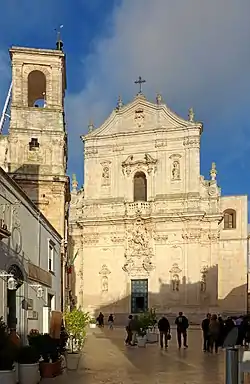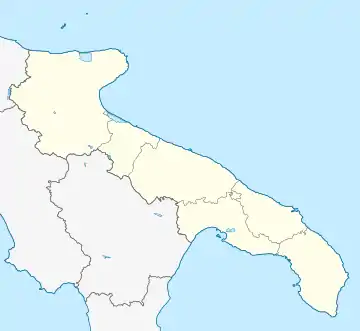Martina Franca
Martina Franca, or just Martina (Martinese: Marténe), is a town and municipality in the province of Taranto, Apulia, Italy. It is the second most populated town of the province after Taranto,[4] and has a population (2016) of 49,086.[3] Since 1975, the town has hosted the annual summer opera festival, the Festival della Valle d'Itria.[5]
Martina Franca | |
|---|---|
| Città di Martina Franca | |
 Piazza Plebiscito and the Cathedral | |
 Coat of arms | |
.svg.png.webp) Martina within the Province of Taranto | |
Location of Martina Franca 
| |
 Martina Franca Location of Martina Franca in Italy  Martina Franca Martina Franca (Apulia) | |
| Coordinates: 40°38′N 17°02′E | |
| Country | Italy |
| Region | Apulia |
| Province | Taranto (TA) |
| Founded | 1300 AD [1] |
| Frazioni | Baratta, Capitolo, Cappuccini, Carpari, Gemma, Infarinata, Lamia Vecchia, Madonna dell'Arco, Monte Fellone, Monte Ilario, Montetulio, Monti del Duca, Motolese, Nigri, Ortolini, Papadomenico, Pergolo, Pianelle, San Paolo, Specchia Tarantina |
| Government | |
| • Mayor | Francesco Ancona (PD) |
| Area | |
| • Total | 299.72 km2 (115.72 sq mi) |
| Elevation | 431 m (1,414 ft) |
| Population (31 December 2017)[3] | |
| • Total | 48,884 |
| • Density | 160/km2 (420/sq mi) |
| Demonym(s) | Martinesi |
| Time zone | UTC+1 (CET) |
| • Summer (DST) | UTC+2 (CEST) |
| Postal code | 74015 |
| Dialing code | 080 |
| Patron saint | San Martino |
| Website | Official website |
.jpg.webp)
_-_palazzo_Martucci.JPG.webp)
_-_palazzo_ducale.JPG.webp)
_-_piazza_XX_settembre.JPG.webp)
_-_villa_comunale_1.JPG.webp)
History
Jewish presence
In 1495 one third of the population of Martina was made of practising Jews or Jews converted to Christianity. The escape involved one third of the population: 150 to 200 families (at least one thousand people). Among the privileges granted the city council of Martina in 1495, King Frederick of Aragon forbade Jews and Crypto-Jews and Neofiti to press charges against those who robbed them (probably during the riots of 1494–1495 during the French invasion of the Kingdom of Naples) and prohibited their coming to live in that city. Also in 1495, the Jews Martina Franca were massacred.
Geography
Located in Itria Valley, close to the provinces of Bari and Brindisi, Martina Franca borders with the municipalities of Alberobello (BA), Ceglie Messapica (BR), Cisternino (BR), Crispiano, Massafra, Mottola, Locorotondo (BA), Ostuni (BR), Villa Castelli (BR), Grottaglie and Noci (BA).[6] It counts the hamlets (frazioni) of Baratta, Capitolo, Cappuccini, Carpari, Gemma, Infarinata, Lamia Vecchia, Madonna dell'Arco, Monte Fellone, Monte Ilario, Montetulio, Monti del Duca, Motolese, Nigri, Ortolini, Papadomenico, Pergolo, Pianelle, San Paolo and Specchia Tarantina.
Culture
The opera Festival della Valle d'Itria is held annually in July/August. It presents a variety of rather unusual operas.[5]
Economy
Agriculture is concentrated in the fertile lands in small valleys. The Viticulture is mainly based on white grape wine. There are also many olive trees growing, in fact olive oil is also one of the main product of the area. The most common livestocks are sheep and goats, to which is added the breeding of thoroughbred "murgese" horses and the famous donkey of Martina Franca. The most developed industry is the textile manufacturing, that made Martina famous also in the movie industry for a big international film in the 80's. The services sector is characterized by banks, insurances and tourism, especially eno-gastronomic one. It is very common for tourists to visit oil mills, wine-making facilities and cellars to taste amazing local products. One of the most important culinary excellence is the "Capocollo Di Martina Franca" [7] a DOP quality product.
Main sights
The town has a particularly conserved old town surrounded by stone walls with prominent Baroque gates leading to piazzas and narrow, winding streets. Piazza Roma is the largest square in the old town, with a green space in the centre of a largely triangular grass pattern, facing the 17th-century Palazzo Ducale.[8]
Gastronomy
Martina Franca DOC
The comune of Martina Franca produces a white Denominazione di origine controllata (DOC) Italian wine that can be made in a still or sparkling Spumante style. The wine has a tendency not to age well, often turning from a light white color to a darker amber color and losing its fresh fruit flavors after only 3 to 4 years in the bottle. All grapes destined for DOC wine production needing to be harvested to a yield no greater than 13 tonnes/ha. The wine is made predominantly (50-65%) from Verdeca and Bianco d'Alessano which can make between 45-40% of the blend. Additional grapes are permitted up to a maximum of 5% including Bombino bianco, Fiano and Malvasia Toscana. The finished wine must attain a minimum alcohol level of 11% in order to be labelled with the Martina Franca DOC designation.[9]
Sports
The town's football team is the A.S. Martina Franca 1947, which are currently plays in Lega Pro. Its home ground is the Gian Domenico Tursi Stadium. Antonio Giovinazzi formula one driver was born in Martina Franca.
The local futsal club is the LCF Martina. It was founded in 2009 and its home ground is the PalaWojtyla.
Transport
Martina Franca railway station[10] in an important junction point between the lines Bari–Martina–Taranto and Martina–Lecce, both operated by the Ferrovie del Sud Est (FSE). A minor station on the line to Taranto, Martina Franca Colonne Grassi,[11] is located in the southwestern suburb. Another minor stop, San Paolo,[12] serves the homonym frazione.
References in popular culture
In the novel Artemis Fowl by Eoin Colfer, Martina Franca is the setting of a troll attack.
Personalities
- Giuseppe Aprile (1732-1813), composer and castrato
- Pietro Carbotti, Venerable
- Domenico Carella (1721-1813), painter
- Donato Carrisi (1973), thriller writer
- Gioconda de Vito (1907-1994), violinist
- Matteo Fischetti (1830–1887), pianist and composer
- Antonio Giovinazzi (1993), racing driver
- Paolo Grassi (Milan, 1919 - London, 1981), founder of the Piccolo Teatro di Milano and director of the Teatro alla Scala.
- Cosimo Damiano Lanza (Leporano, 1962), pianist, harpsichordist and composer. Director of the Accademia Musicale Mediterranea in Martina Franca.
- Renzo Rubino (Taranto 1988), Singer-Songwriter, raised by parents of Martina Franca.
- Richard Sinclair (Canterbury, 1948), English progressive rock musician, who lives in the countryside of Martina.
- Rudolph Valentino (Castellaneta, 1895 - New York City, 1936), American actor. His father came from Martina Franca.
See also
References
- Martina Franca Official Website
- "Superficie di Comuni Province e Regioni italiane al 9 ottobre 2011". Istat. Retrieved 16 March 2019.
- (in Italian) Source: Istat 2016
- List of municipalities in Taranto Province (Apulia Region) ordered by population
- (in Italian) Festival della Valle d'Itria Official Website Archived 2017-03-30 at the Wayback Machine
- 40610 Martina Franca on OpenStreetMap
- (in Italian) Capocollo di Martina Franca Archived 2015-09-24 at the Wayback Machine (fondazioneslowfood.com)
- Martina Franca | Italy | Encyclopædia Britannica
- P. Saunders Wine Label Language pg 174 Firefly Books 2004 ISBN 1-55297-720-X
- 1768769698 Martina Franca railway station on OpenStreetMap
- 1770045597 Martina Franca Colonne Grassi railway station on OpenStreetMap
- 1384593442 San Paolo railway station on OpenStreetMap
Sources
- Jewish Virtual Library
- C. Colafemmina, Gli ebrei a Taranto (2005)
- N. Ferorelli, Gli Ebrei nell’Italia meridionale, dall’età romana al secolo XVIII
External links
| Wikimedia Commons has media related to Martina Franca. |
- Official website (in Italian)
- Website of the Festival della Valle d'Itria (in Italian)
- Martina Franca on Flickr